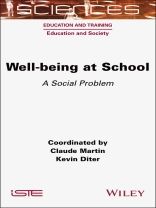In recent decades, children’s well-being, particularly at school, has become a major political and academic issue that has gained importance both in public policy and in the social sciences.
Well-being at School uncovers and discusses the different ways in which school well-being has been defined and evaluated, by outlining the international and interdisciplinary state of the art. It presents recent and diversified empirical evidence in different European and non-European countries, which bring together perspectives that have often been arbitrarily and artificially opposed in the literature: objective well-being versus subjective well-being; adult-centered perspective versus child-centered perspective; and analysis of family determinants versus analysis of school determinants of child well-being.
This book’s originality lies in simultaneously considering the multiple dimensions of children’s well-being at school and understanding how these different determinants interact and combine, depending on the (geographical, social and family) contexts in which the children live.
Содержание
Acknowledgments xiii
Introduction
Kevin Diter And Claude Martin
Part 1 Well-being and Ill-being from Public Policies’ Perspectives 1
Chapter 1 The Impact of a “Crisis” of Well-being on Goals and Practices in the British Educational System 3
Kathryn Ecclestone
1.1 Introduction 3
1.2 The cultural turn toward psychological vulnerability 6
1.2.1 An unprecedented crisis? 6
1.2.2 Therapeutic cultural narratives 9
1.2.3 The cultural turn to psychological “vulnerability” 11
1.3 Changing the human and curriculum subject of education 13
1.3.1 Approaches to well-being 13
1.3.2 Concept creep 15
1.4 Problems with the evidence-base 18
1.4.1 Evaluations of policy-led well-being initiatives in British schools 18
1.4.2 Weak concepts and measures 18
1.5 Educational alternatives to well-being 20
1.6 Conclusion 22
1.7 References 23
Chapter 2 New Zealand: Educational Inequality in a High-performing System 31
Grant Duncan
2.1 Well-being 32
2.2 Well-being and schools 37
2.3 New Zealand: A brief history 39
2.4 The contemporary scene 40
2.5 “Te Kotahitanga” 44
2.6 The Covid-19 pandemic 47
2.7 Conclusion 48
2.8 References 50
Chapter 3 Is Early Childhood Education Part of the Solution to Inequalities, or is it Part of the Problem? 55
Michel Vandenbroeck
3.1 Introduction: from outcomes to opportunities 55
3.2 Quality and beyond 58
3.3 Moderate quality 61
3.4 Unequal access 63
3.5 Discussion: a remarkable paradox 65
3.6 References 66
Part 2 Family–School Relationships and Children’s Well-being 73
Chapter 4 The Conditions for Effective Parental Involvement at School 75
Sandrine Garcia
4.1 Families who anticipate difficulties 78
4.2 Problem-solving families 81
4.3 Powerless families 84
4.4 Conclusion 87
4.5 References 88
Chapter 5 School, Peers and Parental Expectations: Understanding “Ill-being” at School 91
Agnès Grimault-Leprince, Lila Le Trividic-Harrache And Rozenn Nedelec
5.1 Survey method 94
5.2 Areas of differentiation in subjective school experience 95
5.3 Characterizing student experience profiles 98
5.4 Difficulty at school and perceived family expectations of schooling 101
5.5 School ill-being and the configuration of social bonds 102
5.6 Conclusion 106
5.7 References 107
5.7 Appendices 110
Chapter 6 “Well-being” in Harmony with “Performance”: Understanding Parental Choice of Montessori Private Schooling 117
Ghislain Leroy And Julie Pinsolle
6.1 Introduction 117
6.2 Understanding parental rejection of “mainstream” schools 119
6.2.1 The broken arm, the mammoth, and the mold 119
6.2.2 Parents in search of a “personalized” learning experience 122
6.2.3 Recent changes in state schools and society 123
6.3 Understanding the refusal of “mainstream” schools 124
6.3.1 Parent–teacher relations 124
6.3.2 Beyond pedagogical personalization: welcoming the child as a whole person 125
6.3.3 The Montessori community and difference 127
6.4 What kind of individualization are Montessorian parents looking for their children? 128
6.4.1 Personalized education at home 129
6.4.2 The mother at the service of the individual child 130
6.4.3 Socializing to achieve autonomy and hidden childhood constraints 132
6.5 Conclusion: interpreting the relationship between “well-being” and performance in early childhood 134
6.6 References 136
Part 3 School Climate and Children’s Well-being at School 139
Chapter 7 Unequal Impact of School-related Factors on Low Levels of Subjective Well-being Among Students in France, the UK and Portugal 141
Kevin Diter And Claude Martin
7.1 Introduction: from well-being to ill-being and back again 141
7.1.1 Understanding well-being: from a negative to a positive definition 141
7.1.2 Role of school climate in determining the level of children’s SWB 143
7.1.3 From the determinants of well-being to the determinants of ill-being: the contribution of comparison 144
7.2 Data and methods 145
7.2.1 The PISA 2015 Survey 145
7.2.2 Students’ level of SWB and its main determinants 146
7.2.3 Methodology: why use stratified (multilevel) analyses? 149
7.3 Findings 150
7.3.1 Low level of well-being unequally distributed depending on the country 150
7.3.2 Low level of well-being unequally distributed according to gender and social class 152
7.3.3 The central role of school-based factors, and in particular stress related to performance 155
7.3.4 School-related factors have different impacts depending on the country 157
7.3.5 School-related factors have different impacts depending on social class 162
7.3.6 Different school determinants depending on social class and geography 164
7.4 Discussion 165
7.5 Conclusion 169
7.6 References 170
7.7 Appendices 175
Chapter 8 Building Stronger Student–Teacher Relationships to Improve Youth Opportunities and Well-being 177
Maia Cucchiara
8.1 Key terms and concepts 179
8.2 Why STRs matter 181
8.3 Group variations in STRs 184
8.4 Improving STRs, enhancing opportunities and well-being 186
8.4.1 Teachers’ practices 186
8.4.2 School-level practices 189
8.4.3 Organizational structures 190
8.5 Putting relationships first 191
8.6 Conclusion 192
8.7 References 193
Chapter 9 Trends in Teenage Mental Health and Well-being: Parents, Peers and Poverty Shame 199
Dimitra Hartas
9.1 Introduction 199
9.2 Measure 202
9.2.1 Background 203
9.2.2 Parent–young person communication 203
9.2.3 Peer interactions – bullying 204
9.2.4 Poverty shame 204
9.2.5 Well-being and mental health 204
9.3 Discussion of findings and conclusions 206
9.3.1 Parents, peers and young people’s well-being 206
9.3.2 Girls’ and young women’s well-being: a sign of gender inequality? 208
9.3.3 Moving into a precarious adulthood 210
9.3.4 Poverty shame and well-being: a social rather than an individual malaise 211
9.4 Final thoughts 213
9.5 References 214
9.6 Appendix 217
9.6.1 Data analytic plan 217
9.6.2 Gender and age analyses for 10- to 15-year-olds 217
9.6.3 Gender and age analyses for 16- to 21-year-olds 218
9.6.4 All regression models were strong and fitted the data well 219
Part 4 Well-being and Ill-being from Children’s Perspectives 223
Chapter 10 Well-being, Recognition and Participation: The Challenge for Schools 225
Nigel Patrick Thomas
10.1 Introduction 225
10.2 “Improving approaches to well-being in schools: What role does recognition play?” 226
10.2.1 Context and theoretical framing 227
10.2.2 Methods employed 229
10.2.3 Results of policy analysis 230
10.2.4 Results of focus groups and interviews 232
10.2.5 Results of online survey 235
10.2.6 Learning from the well-being research 237
10.3 “Improving well-being through student participation at school” 237
10.3.1 Aims and methods 238
10.3.2 Delivery and key findings 239
10.3.3 Theoretical and practical implications of the research 244
10.4 Acknowledgments 246
10.5 References 246
Chapter 11 Re-imagining Schooling from the Perspectives of Marginalized Children and Young People: Balancing Children’s Rights and Rights Claims Alongside the Expectations of Parents and Governments 251
Cath Larkins
11.1 Introduction 251
11.2 Context 253
11.2.1 Understanding education, well-being and citizenship from children’s perspectives 253
11.2.2 The background studies 257
11.3 Marginalized children and young people’s aspirations for well-being in education 260
11.3.1 Peer relationships 260
11.3.2 Enough supportive teaching staff 261
11.3.3 Respect for ethnic and cultural diversity 263
11.3.4 Punishment and privacy 264
11.3.5 Learning opportunities and assessment 265
11.3.6 Participation? 267
11.4 Some conclusions 269
11.5 References 270
List of Authors 275
Index 277
Об авторе
Claude Martin is a sociologist, emeritus research professor at the Center for National Scientific Research (CNRS), and a member of the laboratory Arènes, University of Rennes, France. His research interests include welfare state comparison, childcare, family, parenting and long-term care policies.
Kevin Diter is Associate Professor of Sociology at the University of Lille and is a member of the Clersé Research Laboratory, France. His expertise lies at the intersection of the sociology of socialization, the sociology of childhood, and the sociology of emotions.












